Just a few weeks ago I posted about woolly aphids on the Hazel Alder here in our Wetlands. In that post I mentioned the possibility of Harvesters, the only North American carnivorous butterfly, making an appearance. Well, they have arrived…at least in caterpillar form. Of course, for the caterpillars to be here there had to have been a butterfly present at some point to lay eggs. It must have done its egg laying while I was making the rounds, because I didn’t see one.
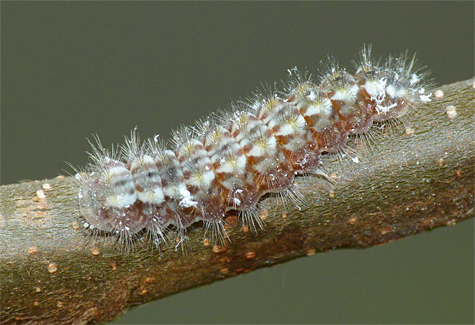
When I say that the butterfly is carnivorous I mean the larva, or caterpillar, is carnivorous. It eats meat, more specifically, aphids. The caterpillars went right to work on the alder’s woolly aphids. I was able to count at least five caterpillars, but there were probably more.
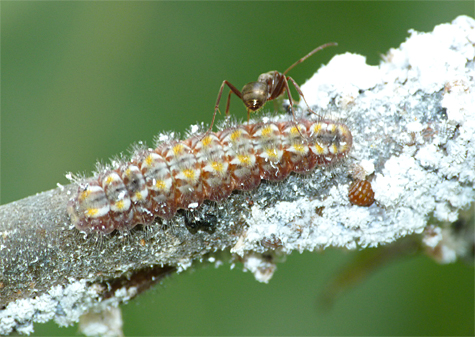
There’s a special relationship between some species of ant, the Harvester caterpillars, and the aphids. The aphids are at the center of it all and are on the alder (I’ve also seen all of these creatures on American Beech) to suck the sap from its branches and twigs. The ants, of more than a few species, are on this same alder to get honeydew from the aphids. The ants may even protect the aphids from predators in order to insure a steady supply of honeydew for their nest. The caterpillars, as you now know, are there to eat the aphids.
The aphids secrete honeydew which attracts the ants as well as various wasps. The adult Harvester butterflies also consume the honeydew but in addition extract nutrients from dung, carrion, and mud. Besides all of the characters collected on the plant to sip honeydew, lady bugs and their larvae eat the aphids alongside the caterpillars.
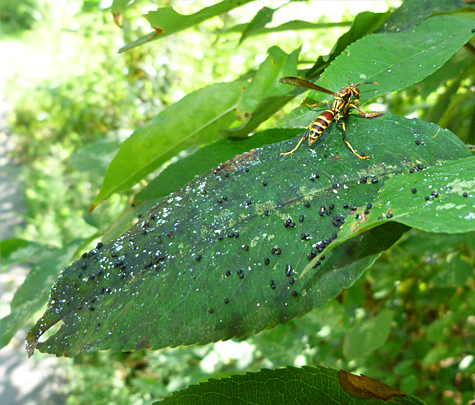
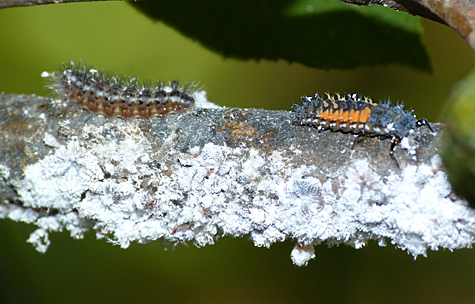
The harvester caterpillars may at times cover themselves with the waxy substance, or “wool,” produced by the aphids, but so far I’ve only seen one caterpillar on this plant that has used this apparent method of camouflage. The waxy covering does an excellent job of concealing the larvae so I may simply have overlooked others.
Some studies have suggested that these caterpillars are less likely to camouflage themselves when certain species of ant are present and tending to the aphids. You can read more about that at this University of Florida website.
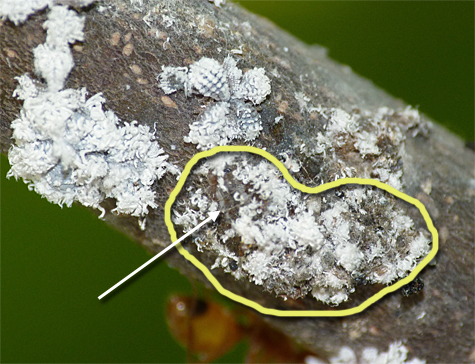
When the caterpillar has eaten enough it crawls off to find a safe location to pupate. The first chrysalis that I discovered was not quite a chrysalis when I found it. A caterpillar had crawled away from the feeding area of the alder and out onto the topside of a leaf. There, the caterpillar sat for several days before begining to form the actual chrysalis.

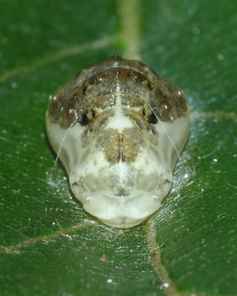
Three days later, the caterpillar began to change form, it began to darken in some areas and harden.
I was able to find two such pupae, or chrysalids, on alder leaves just a few feet from where the caterpillars had fed. Some say the chrysalis looks like the face of monkey, others a snake head. To me, it resembles a skull. One naturalist here at the Museum suggested the chrysalis looks like “The Face on Mars.” What do you think?
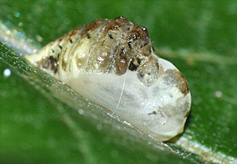
This is a sought after species by butterfly enthusiasts, the last one I photographed was some ten years ago and it was another five years beyond when I saw one before that. I don’t go hunting for these butterflies but that time period gives you some idea of how often you can expect to see one of these butterfies if you’re a casual lepidoterist.
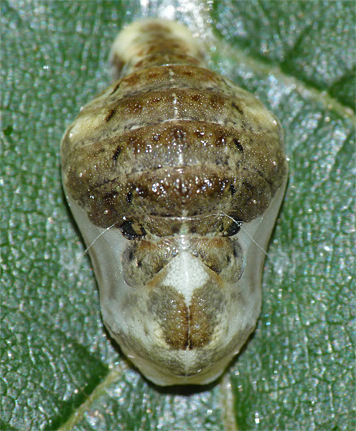
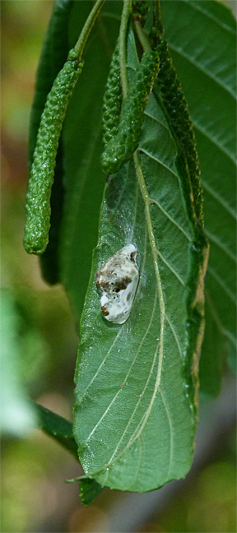
Although Harvesters are widespread across the state they are considered rare, apparently due to their specialized diet. They’re more common in the mountains, less so in the Piedmont (where we happen to be) and considered very rare on the coastal plain.
But don’t fret, if you want to see one of these butterflies, spend enough time near bodies of water where alders grow, you’re chances of seeing them will increase. Look for the aphids, which are much easier to locate than the butterfly itself, and keep checking the area. Sooner or later you’re likely to see a butterfly, or at least the caterpillars. But remember, you may have to spend a bit of time looking for the caterpillars as well since they may have the appearance of a mass of aphids while adorned in their camouflage attire, as they sometimes are.
With all this talk of caterpillars and pupae you’re probably wondering what the butterfly itself looks like. I’ve been waiting, not so patiently, for one to emerge, or eclose, from a chrysalis for the past week in order to show you what they look like. Unfortunately, I may miss this event since I will not be able to check on the chrysalids for the next three days (till Wednesday, 9/18). Hopefully, the cooler nighttime temperatures that are forecast for those three days will delay the butterfly’s emergence long enough for me to be there when one of them actually does eclose.
Luckily for you, and through the magic of the internet, you can Google “Harvester Butterfly” and see many photos of the adult butterflies. I will, however, be there bright and early Wednesday morning with camera in hand to photograph the emergence if it is delayed.
Enjoy!
